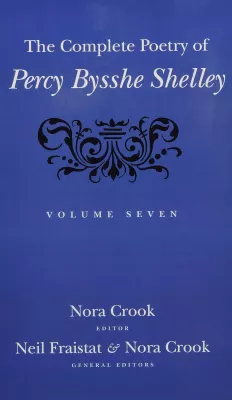Published

Nora Crook, ed., The Complete Poetry of Percy Bysshe Shelley, Volume Seven (The Johns Hopkins University Press, 2021). 1040 pp., 7 b&w illus. (Hdbk., $140.00; ISBN 9781421437835).
Nora Crook’s magisterial and majestic contribution to The Johns Hopkins University Press’s Complete Poetry of Percy Bysshe Shelley series jumps chronologically from volume three to seven by addressing the contents of the Mary Shelley-edited Posthumous Poems of Percy Bysshe Shelley (1824). As series co-editor Neil Fraistat explained at this edition’s virtual launch party in May 2021, when Crook was brought onto the larger CPPBS project as a general editor, she began working backwards from the end of Shelley’s life and career, and the forthcoming volumes four through six will meet in the series’ middle and fill in the gaps between the works addressed in volumes one through three (from Shelley’s earliest juvenilia through the 1816 Alastor volume and Laon and Cythna) and the very last works included in volume seven. Like the previous CPPBS editions, Crook’s latest contribution is both indispensable and delightful, a resource to be prized not only for its careful and authoritative presentation of Shelley’s poetry but also for the incisive commentary and contextualization Crook provides throughout.
This latest and, eventually, penultimate volume in the CPPBS series (the final volume will apparently consist of translations) is almost as much a study of Mary Shelley as a posthumous editor and collaborator as it is of Percy Shelley’s late work, and the volume’s opening “Editorial Overview” section provides a concise yet exhaustive summary of the creation, publication, and afterlives of the verse first printed in the 1824 Posthumous Poems volume and its critical role in Percy Shelley’s subsequent reception and reputation. Since virtually every work included in this volume is fragmentary, Crook addresses Mary’s active and sometimes idiosyncratic editing and collecting of Percy’s poetry and its status as what Crook has elsewhere referred to as a “posthumous collaboration” rather than mere editing. The “Editorial Overview” also offers a pithy treatment of Mary Shelley’s various maneuvers within the volatile publishing climate of the 1820s and how she was willing to display the more “shocking” versions of her late husband’s work to the reading public only “at the right time” (xxv). Crook also notes that Mary Shelley “taught all subsequent editors how to read” Percy Shelley’s challenging and often exasperating handwriting (xxxii), and this volume departs from volumes one through three in introducing abbreviations (including canc. for canceled, om. for omitted, and poss. for possibly) to indicate any uncertain readings over the last two hundred years of editing and publication.
The volume’s overall layout—similar in many ways to its predecessors’—includes an “Historical Collations” section that traces readings through significant editions from 1824 until 2014. Other useful appendices include the Contents of Posthumous Poems and a guide on where to find those works in other volumes in the CPPBS series, a list of manuscript sources of the items Crook uses in this volume, Mary Shelley’s preface to Posthumous Poems, the Italian source material for “Ginevra” (Shelley’s final verse narrative), and other relevant ancillary materials. But the twin hearts of this edition are, of course, “Texts” and “Commentaries,” the former providing the now-definitive texts of each work and the latter a collection of acute analyses that represents the lion’s share of this volume’s thousand pages. In a slight but useful departure from the earlier volumes in this series, each commentary opens with a headnote that provides item-specific notes as well as information about the text’s genesis and transmission and critical history. The layout of the “Texts” section—and the series’ general practice of separating the text from the commentary in discrete sections—allows for a reading experience in which the critical apparatus does not necessarily interfere; the commentary is accessible when it is needed but unobtrusive when it is not. Even given the size and heft of this volume (at almost four pounds, it is rather akin to a beautiful blue cinder block), it remains relatively easy to toggle back and forth between Text and Commentary or simply to engage with the text sans scholarly apparatus, if desired.
In her Acknowledgements, Crook notes that she began work on this volume in 2004, and the considerable labor involved is apparent on every page of this meticulous volume. These JHUP editions of the Complete Poetry of Percy Bysshe Shelley are, without question, invaluable tools that are destined to become the definitive editions of Shelley’s poetry, and it is especially bittersweet to open the leaves of volume seven to see as its frontispiece Shelley’s own sketches of sailboats, a grim reminder that this volume contains the last words he would ever write. As both a scholarly apparatus and a celebration of Shelley’s poetry, this volume shines.
